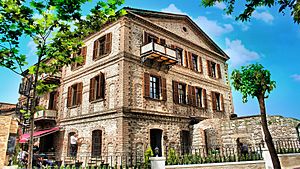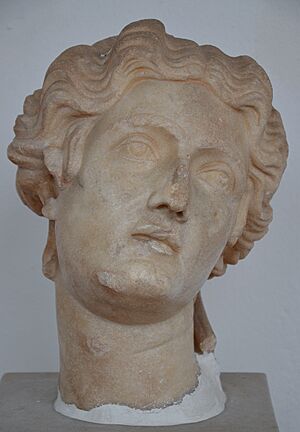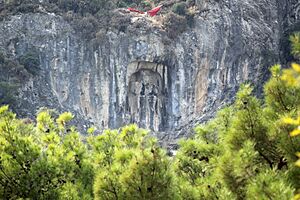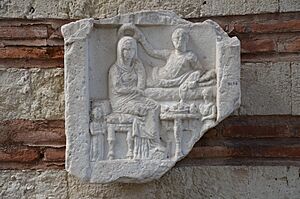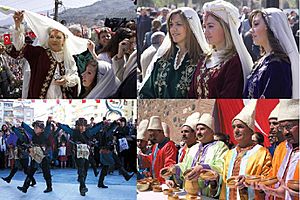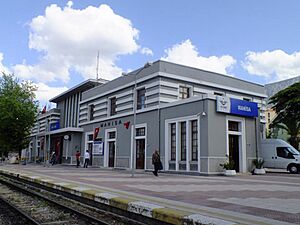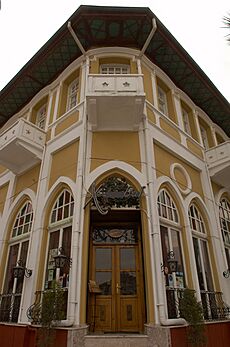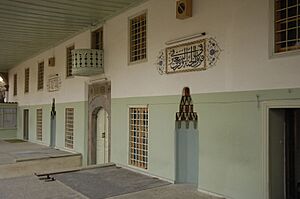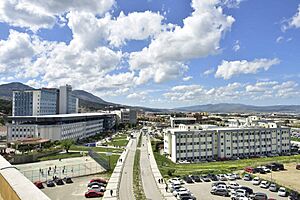Manisa facts for kids
Quick facts for kids
Manisa
|
||
|---|---|---|
|
Metropolitan municipality
|
||
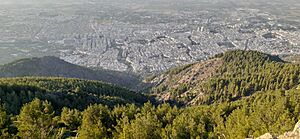
Aerial view of Manisa
|
||
|
||
| Country | ||
| Province | Manisa | |
| Elevation | 71 m (233 ft) | |
| Population
(2022)
|
||
| • Urban | 385,452 | |
| Time zone | UTC+3 (TRT) | |
Manisa is a city in Turkey, located in the Aegean Region. It's about 40 kilometers northeast of the big city of İzmir. In 2022, Manisa had a population of 385,452 people.
Today, Manisa is a busy center for industry and services. It's close to İzmir, which has an international port. Manisa also has rich farmlands that produce many different crops. Many people travel daily between Manisa and İzmir, which are connected by a good highway. This road goes over Mount Sipylus, a famous mountain with many myths.
The older part of Manisa is nestled in a valley on the slopes of Mount Sipylus. A stream called Çaybaşı flows by the "Weeping Rock" ("Ağlayan Kaya"), which is linked to the ancient story of Niobe. There's also an old bridge called the "Red Bridge." Over the past few decades, Manisa has grown a lot, spreading across the wide plain formed by the River Gediz. New apartment buildings, industrial zones, and the Celal Bayar University campus have helped it grow.
Manisa is also a popular place to visit, especially during its festivals in March and September. The March festival celebrates a 500-year-old tradition of distributing "Mesir Paste." The nearby Mount Spil national park is also a big draw. From Manisa, you can easily visit other famous places like Sardes and Alaşehir.
Contents
Discovering Manisa's Name and History
What Does "Manisa" Mean?
Historically, Manisa was known as Magnesia, specifically Magnesia ad Sipylum. This helped tell it apart from another city called Magnesia on the Maeander. People believe the name "Magnesia" came from a tribe called the Magnetes. They might have moved here from a place called Thessaly a very long time ago.
The name "Magnesia ad Sipylus" refers to Mount Sipylus (also called Mount Spil). This mountain stands tall over the city. Magnesia became an important city after the Romans took control, especially after the Battle of Magnesia in 190 BC.
The English words "magnesia", "magnet", and "magnetism" might have come from the city's name.
Manisa: The City of Princes
Under Turkish rule, the city was also linked to the "Saruhan" family. They ruled this region before the Ottoman Empire. The city's name "Manisa" (ماغنيسا) has been used ever since.
During the early Ottoman Empire, many sons of the sultans (who were like princes, called shahzades) came to Manisa for their education. Because of this, Manisa is still known in Turkey as "the city of shahzades" (Şehzadeler şehri). Only two other cities share this special title.
A Journey Through Time: Manisa's Past
Ancient Footprints and Cultures
Even though there aren't many very old traces in the Manisa region, some discoveries are very exciting. In 1969, over fifty fossilized footprints were found in Sindel village. These footprints are about 20,000 to 25,000 years old! Some of them are now in the Manisa Museum. The site where they were found might become Turkey's first geopark.
Another important discovery was tombs from the time of Troy II (3000-2500 BC). These were found in Yortan village. The way people were buried here led experts to define a special "Yortan culture" from this ancient period.
Powerful Kingdoms of Ancient Anatolia
In ancient times, the western part of Anatolia was home to the Luwian kingdom of Arzawa. Later, the powerful Hittite Empire had influence here. A special monument to the goddess Cybele on Mount Sipylus shows how important the Hittites were in this area.
Later, the "Phrygians" and "Maeonians" lived here. Their stories are often mixed with myths. Finally, the Lydians became very powerful. Famous mythical figures like Tantalus, Pelops, and Niobe are linked to Mount Sipylus. This mountain was likely where the first city in the area was built.
In the 7th century BC, the Lydians, led by the Mermnad dynasty, took control of a large part of Anatolia. Their capital city was "Sfard" (also called Sardis), which was about 62 kilometers from Manisa. You can still see remains from several ancient civilizations at this capital site today.
Roman and Byzantine Times
The Romans knew the city as Magnesia ad Sipylum. In 190 BC, the Roman army defeated King Antiochus the Great in the Battle of Magnesia here. Magnesia became a very important city under Roman rule. Even after a big earthquake during the time of Emperor Tiberius, the city was rebuilt and continued to thrive.
In 1076, the Byzantine Empire lost the city to the Seljuks. However, the Byzantines got Magnesia back after a victory in the Battle of Dorylaeum (1097). Magnesia was a key regional center for the Byzantines. During the time of the Empire of Nicea (1204-1261), Magnesia was so important that it had the Imperial mint and treasury. It even served as the capital until Constantinople was recovered in 1261.
Turkish Rule: Seljuks, Saruhan, and Ottomans
In the early 1300s, Turkish groups often raided the Magnesia region. Many people left the city because of these attacks. In 1313, Manisa became a permanent Turkish city when it was taken by the Saruhan Beylik. This group was led by a ruler named Saruhan. His family ruled the region until 1390, when it became part of the growing Ottoman Empire. Manisa officially joined the Ottoman Empire in 1410.
By the 15th century, Manisa was rebuilt and became a very rich part of the Ottoman Empire. Many beautiful examples of Ottoman architecture were built here. From 1437 to 1595, many Ottoman princes (shahzades), including famous ones like Mehmed II and Süleyman I, lived and learned how to govern in Manisa. This helped them prepare to become sultans. This practice stopped in 1595 because of growing problems in the countryside and a strong earthquake.
Around 1700, Manisa was a busy city known for its cotton markets and a special type of leather. It was a stopping point for trading caravans coming from the east.
Manisa in the Late Ottoman Period
Manisa was one of the first cities in the Ottoman Empire to get a railway line. Construction started in 1863 from İzmir and reached Manisa's nearby district of Kasaba (now Turgutlu) in 1866. This railway helped connect Manisa to other important areas and trade routes.
Manisa in the 20th Century
Manisa was occupied by the Greek Army in May 1919 during the Greco-Turkish War (1919-1922). It was recaptured by the Turkish Army in September 1922. Sadly, the retreating Greek Army burned the city. More than 90% of Manisa was destroyed. One report said that out of 18,000 buildings, only 500 remained.
After the war, Manisa was rebuilt. In 1923, it became the center of Saruhan Province under the new Turkish Republic. The province and the city were officially renamed Manisa in 1927.
Manisa's Climate
Manisa has a Mediterranean climate. This means it has hot, dry summers and short, cool, wet winters. Summers in Manisa are hotter than in nearby İzmir, and winters are colder because it's further inland. Snowfall is not very common, but it does happen most winters. The most snow recorded was 44 centimeters in January 1945.
The highest temperature ever recorded in Manisa was 45.5°C (113.9°F) on July 25, 2007. The lowest temperature was -17.5°C (0.5°F) on January 4, 1942.
| Climate data for Manisa (1991–2020, extremes 1930–2023) | |||||||||||||
|---|---|---|---|---|---|---|---|---|---|---|---|---|---|
| Month | Jan | Feb | Mar | Apr | May | Jun | Jul | Aug | Sep | Oct | Nov | Dec | Year |
| Record high °C (°F) | 24.2 (75.6) |
26.4 (79.5) |
33.5 (92.3) |
34.7 (94.5) |
40.6 (105.1) |
43.4 (110.1) |
45.5 (113.9) |
44.7 (112.5) |
42.4 (108.3) |
38.2 (100.8) |
31.6 (88.9) |
26.4 (79.5) |
45.5 (113.9) |
| Mean daily maximum °C (°F) | 10.7 (51.3) |
12.9 (55.2) |
16.8 (62.2) |
21.7 (71.1) |
27.6 (81.7) |
32.7 (90.9) |
35.7 (96.3) |
35.7 (96.3) |
31.1 (88.0) |
24.8 (76.6) |
17.6 (63.7) |
12.0 (53.6) |
23.3 (73.9) |
| Daily mean °C (°F) | 6.3 (43.3) |
7.9 (46.2) |
11.0 (51.8) |
15.2 (59.4) |
20.7 (69.3) |
25.7 (78.3) |
28.6 (83.5) |
28.5 (83.3) |
23.7 (74.7) |
18.2 (64.8) |
11.9 (53.4) |
7.8 (46.0) |
17.1 (62.8) |
| Mean daily minimum °C (°F) | 3.0 (37.4) |
4.1 (39.4) |
6.1 (43.0) |
9.6 (49.3) |
14.4 (57.9) |
19.1 (66.4) |
22.2 (72.0) |
22.3 (72.1) |
17.5 (63.5) |
13.1 (55.6) |
7.7 (45.9) |
4.7 (40.5) |
12.0 (53.6) |
| Record low °C (°F) | −17.5 (0.5) |
−10.9 (12.4) |
−6.7 (19.9) |
−2.7 (27.1) |
2.0 (35.6) |
7.4 (45.3) |
10.5 (50.9) |
8.5 (47.3) |
3.3 (37.9) |
−0.9 (30.4) |
−7.3 (18.9) |
−9.9 (14.2) |
−17.5 (0.5) |
| Average precipitation mm (inches) | 123.5 (4.86) |
108.4 (4.27) |
75.9 (2.99) |
54.9 (2.16) |
39.0 (1.54) |
25.1 (0.99) |
7.7 (0.30) |
11.2 (0.44) |
22.8 (0.90) |
53.8 (2.12) |
85.5 (3.37) |
116.8 (4.60) |
724.6 (28.53) |
| Average precipitation days | 10.53 | 10.87 | 9.17 | 8.43 | 6.87 | 3.67 | 1.07 | 0.87 | 2.57 | 5.93 | 8.5 | 11.73 | 80.2 |
| Average snowy days | 0.6 | 0.56 | 0 | 0 | 0 | 0 | 0 | 0 | 0 | 0 | 0 | 0.31 | 1.47 |
| Average relative humidity (%) | 75.6 | 71.1 | 65.1 | 60.5 | 53.9 | 47.7 | 43.2 | 45.1 | 51.1 | 62.2 | 72.4 | 77.3 | 60.4 |
| Mean monthly sunshine hours | 77.5 | 93.2 | 145.7 | 162.0 | 223.2 | 267.0 | 288.3 | 279.0 | 225.0 | 170.5 | 102.0 | 58.9 | 2,092.3 |
| Mean daily sunshine hours | 2.5 | 3.3 | 4.7 | 5.4 | 7.2 | 8.9 | 9.3 | 9.0 | 7.5 | 5.5 | 3.4 | 1.9 | 5.7 |
| Source 1: Turkish State Meteorological Service | |||||||||||||
| Source 2: NOAA(humidity), Meteomanz(snow days 2008-2023) | |||||||||||||
Manisa's Delicious Food
Manisa is famous for its different kinds of kebabs. One popular dish is Manisa Kebab. It's made with minced beef and lamb, served on chopped pita bread. It comes with grilled tomatoes, peppers, and onion salad. Melted butter and sumac are added on top. You can also eat it with yogurt.
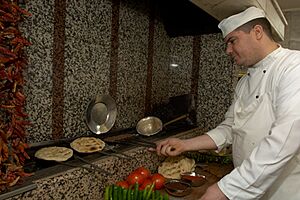
Exploring Manisa's Famous Buildings
The 16th-century Sultan Mosque was built for Ayşe Hafsa Sultan, who was the mother of Süleyman the Magnificent. Every March, the Mesir Festival is held at this mosque to honor her. During the festival, "Mesir Paste" (Mesir Macunu), a spiced candy, is given out. People believe it can bring health and energy. This festival is a big public event.
The mosque is part of a large religious complex called a külliye. One of the most important buildings in this complex is the hospital, called "darüşşifa." This hospital specialized in treating mental diseases. It was used until the early 1900s.
One famous person from Manisa in the 20th century was Ahmet Bedevi, known as the Tarzan of Manisa. He became a symbol for the city because he helped raise awareness about protecting the environment in Turkey. He was especially important in the 1960s when a huge effort was made to plant thousands of trees around Manisa.
The Muradiye Mosque was built in the 16th century by the famous architect Mimar Sinan. The old Murad Bey Medresse building, which was once a school, now houses the Archaeological Museum of Manisa.
Manisa also celebrates the Vintage Festival every September. This festival celebrates the grapes from the vineyards that surround the city. These grapes are used to make wine and dried fruit for export.
Manisa Today: A Modern City
In recent years, Manisa has become a strong industrial city. It started with processing farm products like flour and olive oil, making textiles, and creating farm tools. Growing olives, walnuts, and almonds are still very important farming activities in Manisa.
Many companies in Manisa are involved in making food, building materials, and metal goods. The electronics and electrical appliance industries also employ many people.
In the 1980s, the big Turkish electronics company Vestel chose Manisa as its production base. This helped Manisa become a very advanced industrial center. Today, many well-known international companies, like Indesit (Italy), Bosch (Germany), Rexam (UK), and Imperial Tobacco (UK), have invested in Manisa.
Manisa has been recognized as a great place for business. In 2004/2005, it was named the Most Cost-Effective European city by FDi magazine. This was because of its low office and industrial rents and good labor costs. In 2006/2007, Manisa was also named the winner for "Best Economic Potential in Europe."
The city also has a football team called Manisaspor. They play in the Süper Lig, which is a top football league. Their home stadium is the Manisa 19 Mayis Stadi.
Famous People from Manisa
- Tantalus - A mythical founder of an ancient city called Tantalis.
- Pausanias (geographer) - A Greek traveler and writer from the 2nd century AD (possibly from here).
- Saruhan dynasty - A Turkish family who ruled the Manisa region in the 14th century.
- Lala Mehmed Pasha - An Ottoman grand vizier (a high-ranking official) in the 16th century.
- Gelenbevi Ismail Efendi - A famous Ottoman mathematician.
- Celâl Bayar - A politician who became the 3rd President of Turkey.
- Hilmi Özkök - A General and former Chief of the General Staff of Turkey.
- Kenan Evren - A General and the 7th President of Turkey.
- Bülent Arinç - A politician who was a former president of the Turkish Grand National Assembly.
Manisa's International Friends
Manisa has "twin towns" or "sister cities" around the world. These are cities that form special bonds to promote cultural and economic ties.
 Ingolstadt, Germany
Ingolstadt, Germany Khartoum, Sudan
Khartoum, Sudan Monastir, Tunisia
Monastir, Tunisia Morphou, Cyprus
Morphou, Cyprus Oral, Kazakhstan
Oral, Kazakhstan Osh, Kyrgyzstan
Osh, Kyrgyzstan Prijedor, Bosnia and Herzegovina
Prijedor, Bosnia and Herzegovina Skopje, North Macedonia
Skopje, North Macedonia Yiwu, China
Yiwu, China Höganäs, Sweden
Höganäs, Sweden Forlì, Italy
Forlì, Italy
Images for kids
-
Muradiye Mosque (Manisa) designed by the imperial architect Mimar Sinan
-
16th century hospice and mental hospital built by Ayşe Hafsa Sultan in Manisa.
See also
 In Spanish: Manisa para niños
In Spanish: Manisa para niños





